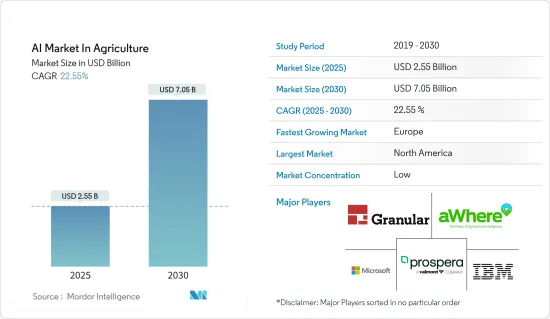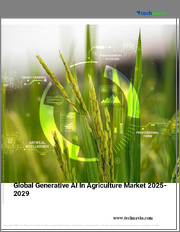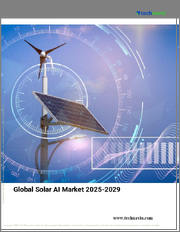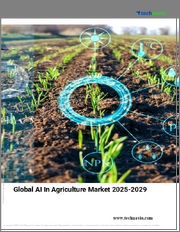
|
시장보고서
상품코드
1641975
농업 분야의 AI : 시장 점유율 분석, 산업 동향과 통계, 성장 예측(2025-2030년)AI In Agriculture - Market Share Analysis, Industry Trends & Statistics, Growth Forecasts (2025 - 2030) |
||||||
농업분야의 AI 시장은 2025년 25억 5,000만 달러에서 2030년에는 70억 5,000만 달러로 성장하며, 예측 기간 중(2025-2030년) CAGR은 22.55%가 될 것으로 예상됩니다.

무인 트랙터는 GPS 기반 기술을 사용하여 자동 조종하고, 지상에서 도구를 들어 올리고, 농장 경계를 인식하고, 태블릿을 사용하여 원격으로 조작 할 수 있습니다. 소형 자동 운전 트랙터의 한 그룹은 농업 종사자의 수익을 10% 이상 올려 농장 인건비를 줄일 수 있습니다.
주요 하이라이트
- 머신러닝 기술을 이용한 작물 수율의 극대화가 시장을 견인하고 있습니다. 품종의 선택은 물과 양분의 이용 효과, 기후 변화에 대한 적응, 내병성, 영양분, 더 나은 맛을 결정하는 특정 유전자를 찾는 번거로운 과정입니다. 머신러닝, 특히 딥러닝 알고리즘은 다양한 기후에서 작물의 성능을 분석하기 위해 수십 년의 필드 데이터를 취합니다. 이 데이터를 바탕으로 어떤 유전자가 식물에 유익한 형질을 가져올 가능성이 가장 높은지를 예측하는 확률 모델을 구축할 수 있습니다.
- 암소 얼굴 인식 기술의 채용 증가가 시장을 견인하고 있습니다. 암소 얼굴 인식 프로그램과 몸 상태 점수 및 섭식 패턴과 결합된 이미지 분류와 같은 고급 메트릭을 적용함으로써 낙농장은 현재 암소 그룹의 모든 행동 측면을 개별적으로 모니터링할 수 있습니다.
- 농업에 있어서의 드론의 사용은 소형의 멀티스펙트럼 이미지 센서에 의한 작물밭의 스캔, 탑재 카메라에 의한 GPS 지도의 작성, 무거운 페이로드의 수송, 서멀 이미징 카메라 탑재 드론에 의한 가축의 모니터링 등에 사용할 수 있기 때문에 농업 농장 전체에서 무인 항공기(UAV)의 사용이 증가하고 있어 UAV 수요를 높여가고 있습니다.
- 그러나 데이터 수집 및 데이터 공유 표준화의 필요성이 높아 시장 성장을 억제하고 있습니다. 머신러닝, 인공지능, 고급 알고리즘 설계는 빠르게 진행되고 있지만, 충분히 태그가 지정된 의미 있는 농업 데이터의 수집은 지연되고 있습니다.
농업의 인공지능(AI) 시장 동향
드론 분석 용도 부문이 큰 시장 점유율을 차지할 전망
- 농업에서 드론 분석과 인공지능의 통합은 농업 최적화, 비용 절감 및 지속가능성 향상에 엄청난 잠재력을 제공합니다. AI의 힘을 활용하여 드론으로 촬영한 데이터를 분석함으로써 농업 종사자는 데이터를 기반으로 의사 결정을 내리고 자원 배분을 개선하고 보다 높은 생산성을 달성할 수 있습니다. 따라서 드론 분석은 농업에서 AI 시장의 중요한 촉진요인이 될 것으로 예상됩니다.
- 고해상도 카메라와 센서를 탑재한 드론은 작물과 토양의 상태, 농장의 특성에 관한 방대한 양의 데이터를 얻을 수 있습니다. AI를 탑재한 분석과 결합하여 농업 종사자는 이 데이터로부터 작물의 건강 상태, 영양 수준, 해충 발생 상황, 농업 생산성에 영향을 미치는 기타 요인에 대한 귀중한 통찰력을 얻을 수 있습니다.
- AI를 탑재한 드론 분석은 현장 내의 특정 지역에 대한 상세한 정보를 제공함으로써 정밀 농업의 실천을 가능하게 합니다. AI 알고리즘을 사용하여 드론으로 촬영한 데이터를 분석함으로써 농업 종사자는 작물 성장, 토양 수분 수준, 해충 개체수의 변화를 확인할 수 있습니다. 이를 통해 적정한 비료, 농약, 관개의 살포 등 적목적 개입이 가능해 자원 이용 최적화와 작물 수율 증가로 이어집니다.
- AI 대응 분석을 탑재한 드론은 작물의 성장 단계 전체를 모니터링할 수 있습니다. 무인 항공기의 이미지와 센서 데이터를 분석함으로써 AI 알고리즘은 식물 스트레스, 질병 발생 및 영양 부족의 초기 징후를 감지할 수 있습니다. 농업 종사자는 그 후 관개 조정, 적절한 치료 적용, 예방 조치 수행 등의 사전 조치를 취함으로써 위험을 줄이고 작물의 건전성을 최적화할 수 있습니다.
- AI를 활용한 드론 분석을 통해 농업 종사자는 광대한 농지를 효율적으로 모니터링할 수 있습니다. 시간이 많이 걸리는 수동 검사를 수행하는 대신 AI 알고리즘이 드론으로 촬영한 데이터를 자동으로 분석하여 주의가 필요한 영역을 식별할 수 있습니다. 이를 통해 작업을 효율화하고 인건비를 줄이고 농업 종사자는 정확하고 시기 적절한 정보를 바탕으로 의사 결정을 내릴 수 있습니다. NASSCOM에 따르면 인도에서는 2025년까지 데이터와 AI 기술을 통해 농업 부문에 약 900억 달러의 부가가치가 탄생한다고 합니다. 모든 부문을 합치면 인공지능은 2025년까지 인도 GDP에 약 5,000억 달러를 올릴 것으로 예측됩니다.
북미가 큰 시장 점유율을 차지할 전망
- 북미 농업에서 인공지능(AI) 시장은 더 큰 농업기술산업 중에서도 중요한 부분입니다. 북미의 농업 AI 시장은 상당한 성장을 이루고 있습니다. 농업에서의 AI 기술의 채용이 증가하고 있기 때문에 시장은 향후 수년에 크게 확대될 것으로 예상됩니다. 생산성 향상에 대한 요구, 정밀 농업 기술에 대한 수요 증가, 첨단 인프라 가용성 등의 요인이 시장 성장에 기여하고 있습니다.
- 북미의 농업 종사자와 농업 사업은 효율성 향상, 자원 배분 최적화, 의사 결정 프로세스 강화를 위한 AI 기술을 도입하고 있습니다. 이 지역의 농업 산업에서 AI 용도로는 정밀 농업, 원격 감지, 작물 모니터링, 예측 분석, 자동 농업 시스템 등이 있습니다. 이러한 기술은 농업 종사자가 데이터를 기반으로 의사 결정을 내리고 수율을 늘리고 비용을 줄이고 위험을 줄이는 데 도움이 됩니다.
- 기술 공급자, 농업 관련 기업, 연구 기관 및 신흥 기업 간의 협업은 북미의 농업 AI 시장을 특징으로합니다. 이러한 협력은 혁신을 촉진하고 이 지역의 농업 분야별 요구에 맞는 AI 주도 솔루션을 개발합니다. AI신흥기업과의 제휴와 투자는 시장의 성장과 기술의 진보에 더욱 기여하고 있습니다.
- 북미의 각국 정부는 농업에서의 AI의 가능성을 인식하고 있으며, 지원 시책과 이니셔티브를 실시했습니다. 여기에는 농업에서 AI의 채용과 혁신을 촉진하기 위한 자금 제공 프로그램, 연구 보조금, 규제 체제 등이 포함됩니다. 이러한 노력은 AI 시장의 성장을 가속하는 환경을 제공하고 지속 가능하고 탄력적 인 농업 시장 개척을 촉진합니다.
- 2023년 1월 미국과 유럽연합(EU)은 인공지능(AI)의 활용을 통해 농업, 기후 예측, 긴급 대응, 전력망을 개선하기 위한 협력 체제를 확립했습니다. 이 협력은 현재 유럽위원회와 27개국으로 구성된 유럽연합(EU)의 집행기관인 백악관 사이에서 이루어지고 있습니다.
농업의 인공지능(AI) 산업 개요
- 농업의 인공지능(AI) 시장은 Microsoft Corporation, IBM Corporation, Granular Inc., aWhere Inc., Prospera Technologies Ltd.와 같은 주요 기업에 의해 분할됩니다. 이 시장 진출 기업은 제품 제공을 강화하고 지속 가능한 경쟁 우위를 얻기 위해 제휴, 협력, 인수 등의 전략을 채택하고 있습니다.
- 2023년 4월 IBM과 Texas A&M AgriLife는 농업 생산성을 향상시키고 경제적 및 환경적 비용을 절감할 수 있는 물 소비 통찰력을 농업 종사자에게 제공하기 위해 협력했습니다. Texas A&M AgriLife와 IBM은 농업 종사자가 미국의 건조 지역에서 '언제 물을 공급해야 하는지'를 결정하는 데 도움이 되는 기술 솔루션인 Liquid Prep을 개발하고 성장시키고 있습니다.
- 2022년 5월, AGRA와 Microsoft는 농업의 디지털 변혁을 지원하기 위해 협력 관계를 확대했습니다. AGRA와 Microsoft는 다보스 회의에서 아프리카 변혁 사무소(Africa Transformation Office)를 통한 향후 협력에 관한 각서에 서명했습니다. 두 조직은 AgriBot의 개발로 이어진 2019년에 시작된 이전 파트너십의 성공을 활용합니다.
기타 혜택
- 엑셀 형식 시장 예측(ME) 시트
- 3개월간의 애널리스트 서포트
목차
제1장 서론
- 조사의 전제조건과 시장 정의
- 조사 범위
제2장 조사 방법
제3장 주요 요약
제4장 시장 인사이트
- 시장 개요
- 산업 밸류체인 분석
- 산업의 매력 - Porter's Five Forces 분석
- 구매자/소비자의 협상력
- 공급기업의 협상력
- 신규 진입업자의 위협
- 대체품의 위협
- 경쟁 기업간 경쟁 관계의 강도
- COVID-19가 농업의 인공지능(AI) 시장에 미치는 영향 분석
제5장 시장 역학
- 시장 성장 촉진요인
- 머신러닝 기술을 이용한 작물 수율 극대화
- 소의 얼굴인식기술 채용 증가
- 농업 현장에서의 무인 항공기(UAV) 이용 증가
- 시장 성장 억제요인
- 데이터 수집에 있어서의 표준화의 부족
제6장 시장 세분화
- 용도별
- 날씨 추적
- 정밀농업
- 드론 분석
- 전개별
- 클라우드
- 온프레미스
- 하이브리드
- 지역별
- 북미
- 유럽
- 아시아
- 호주 및 뉴질랜드
제7장 경쟁 구도
- 기업 프로파일
- Microsoft Corporation
- IBM Corporation
- Granular Inc.
- aWhere Inc.
- Prospera Technologies Ltd.
- Gamaya SA
- ec2ce
- PrecisionHawk Inc.
- Cainthus Corp.
- Tule Technologies Inc.
제8장 투자 분석
제9장 시장 기회와 앞으로의 동향
SHW 25.02.19The AI Market In Agriculture Industry is expected to grow from USD 2.55 billion in 2025 to USD 7.05 billion by 2030, at a CAGR of 22.55% during the forecast period (2025-2030).

The driverless tractor is trending in the market, as these tractors can steer automatically using GPS-based technology, lift tools from the ground, recognize the boundaries of a farm, and be operated remotely using a tablet. A fleet of smaller automated tractors could raise farmer revenue by more than 10 percent and reduce farm labor costs.
Key Highlights
- Maximizing crop yield using machine learning techniques is driving the market. Species selection is a tedious process of searching for specific genes that determine water and nutrient use effectiveness, adaptation to climate change, disease resistance, nutrient content, or a better taste. Machine learning, in particular deep learning algorithms, takes decades of field data to analyze crop performance in various climates. Based on this data, one can build a probability model to predict which genes will most likely contribute a beneficial trait to a plant.
- An increase in the adoption of cattle face recognition technology is driving the market. By applying advanced metrics, including cattle facial recognition programs and image classification incorporated with body condition scores and feeding patterns, dairy farms can now individually monitor all behavioral aspects of a group of cattle.
- The increased use of unmanned aerial vehicles (UAVs) across agricultural farms is driving the market, as the use of drones in the agriculture industry can be used in crop field scanning with compact multispectral imaging sensors, GPS map creation through onboard cameras, heavy payload transportation, and livestock monitoring with thermal-imaging camera-equipped drones, which increases the demand for UAVs.
- However, the need for standardization is restraining market growth as the need for data collection and data sharing standards is high. Machine learning, artificial intelligence, and advanced algorithm design have moved quickly, but collecting well-tagged, meaningful agricultural data is way behind.
Artificial Intelligence (AI) in Agriculture Market Trends
Drone Analytics Application Segment is Expected to Hold Significant Market Share
- Integrating drone analytics and AI in agriculture offers tremendous potential for optimizing agricultural operations, reducing costs, and enhancing sustainability. By leveraging the power of AI to analyze drone-captured data, farmers can make data-driven decisions, improve resource allocation, and achieve higher productivity. Therefore, drone analytics is expected to be a significant driver of the AI market in agriculture.
- Drones with high-resolution cameras and sensors can capture vast amounts of data about crops, soil conditions, and field characteristics. Combined with AI-powered analytics, this data enables farmers to gain valuable insights into crop health, nutrient levels, pest infestations, and other factors influencing agricultural productivity.
- AI-powered drone analytics enable precision agriculture practices by providing detailed information about specific areas within a field. By using AI algorithms to analyze drone-captured data, farmers can identify variations in crop growth, soil moisture levels, or pest populations. This allows for targeted interventions, such as precise fertilizers, pesticides, or irrigation applications, leading to optimized resource utilization and increased crop yields.
- Drones equipped with AI-enabled analytics can monitor crops throughout their growth stages. By analyzing drone imagery and sensor data, AI algorithms can detect early signs of plant stress, disease outbreaks, or nutrient deficiencies. Farmers can then take proactive measures, such as adjusting irrigation, applying appropriate treatments, or implementing preventive measures, to mitigate risks and optimize crop health.
- Drone analytics powered by AI enable farmers to efficiently monitor large agricultural areas. Instead of conducting time-consuming manual inspections, AI algorithms can automatically analyze drone-captured data and identify areas requiring attention. This streamlines operations saves labor costs, and allows farmers to make informed decisions based on accurate and timely information. According to NASSCOM, by 2025, approximately USD 90 billion of value will be added to the agriculture sector through data and AI technologies in India. With all the sectors combined, artificial intelligence is projected to add approximately USD 500 billion to India's GDP by 2025.
North America is Expected to Hold Significant Market Share
- The North American artificial intelligence (AI) market in agriculture is a significant segment within the larger agricultural technology industry. The North American AI market in agriculture has been experiencing substantial growth. With the increasing adoption of AI technologies in the agricultural sector, the market is expected to expand significantly in the coming years. Factors such as the need for increased productivity, rising demand for precision farming techniques, and the availability of advanced infrastructure contribute to market growth.
- North American farmers and agricultural businesses embrace AI technologies to improve efficiency, optimize resource allocation, and enhance decision-making processes. AI applications in the region's agriculture industry include precision agriculture, remote sensing, crop monitoring, predictive analytics, and automated farming systems. These technologies help farmers make data-driven decisions, increase yields, reduce costs, and mitigate risks.
- Collaborations between technology providers, agriculture companies, research institutions, and startups characterize the North American AI market in agriculture. These collaborations foster innovation and the development of AI-driven solutions tailored to the specific needs of the region's agricultural sector. Partnerships and investments in AI startups further contribute to market growth and technological advancements.
- Governments in North America recognize the potential of AI in agriculture and are implementing supportive policies and initiatives. These include funding programs, research grants, and regulatory frameworks to foster AI adoption and innovation in the agricultural sector. Such initiatives provide a conducive environment for AI market growth and facilitate the development of sustainable and resilient agricultural practices.
- In January 2023, the United States and the European Union established a collaboration to improve agriculture, climate forecasting, emergency response, and the electric grid through the use of artificial intelligence (AI). The cooperation is now between the European Commission and the White House, the executive arm of the 27-member European Union.
Artificial Intelligence (AI) in Agriculture Industry Overview
- The artificial intelligence (AI) market in the agriculture market is fragmented with major players like Microsoft Corporation, IBM Corporation, Granular Inc., aWhere Inc., and Prospera Technologies Ltd. Players in the market are adopting strategies such as partnerships, collaborations, and acquisitions to enhance their product offerings and gain sustainable competitive advantage.
- In April 2023, IBM and Texas A&M AgriLife collaborated to provide farmers with water consumption insights, which can boost agricultural productivity while lowering economic and environmental expenses. Texas A&M AgriLife and IBM will deploy and grow Liquid Prep, a technology solution that helps farmers decide "when to water" in dry parts of the United States.
- In May 2022, AGRA and Microsoft expanded their collaboration to help with the digital agricultural transformation. AGRA and Microsoft signed an MoU in Davos for future collaboration through its Africa Transformation Office. The organizations will leverage their success from a previous partnership started in 2019, which led to the development of the AgriBot.
Additional Benefits:
- The market estimate (ME) sheet in Excel format
- 3 months of analyst support
TABLE OF CONTENTS
1 INTRODUCTION
- 1.1 Study Assumptions and Market Definition
- 1.2 Scope of the Study
2 RESEARCH METHODOLOGY
3 EXECUTIVE SUMMARY
4 MARKET INSIGHTS
- 4.1 Market Overview
- 4.2 Industry Value Chain Analysis
- 4.3 Industry Attractiveness - Porter's Five Forces Analysis
- 4.3.1 Bargaining Power of Buyers/Consumers
- 4.3.2 Bargaining Power of Suppliers
- 4.3.3 Threat of New Entrants
- 4.3.4 Threat of Substitute Products
- 4.3.5 Intensity of Competitive Rivalry
- 4.4 Analysis on the impact of COVID-19 on the Artificial Intelligence (AI) Market in Agriculture
5 MARKET DYNAMICS
- 5.1 Market Drivers
- 5.1.1 Maximize Crop Yield Using Machine Learning technique
- 5.1.2 Increase in the Adoption of Cattle Face Recognition Technology
- 5.1.3 Increase Use of Unmanned Aerial Vehicles (UAVs) Across Agricultural Farms
- 5.2 Market Restraints
- 5.2.1 Lack of Standardization in Data Collection
6 MARKET SEGMENTATION
- 6.1 By Application
- 6.1.1 Weather Tracking
- 6.1.2 Precision Farming
- 6.1.3 Drone Analytics
- 6.2 By Deployment
- 6.2.1 Cloud
- 6.2.2 On-premise
- 6.2.3 Hybrid
- 6.3 By Geography
- 6.3.1 North America
- 6.3.2 Europe
- 6.3.3 Asia
- 6.3.4 Australia and New Zealand
7 COMPETITIVE LANDSCAPE
- 7.1 Company Profiles
- 7.1.1 Microsoft Corporation
- 7.1.2 IBM Corporation
- 7.1.3 Granular Inc.
- 7.1.4 aWhere Inc.
- 7.1.5 Prospera Technologies Ltd.
- 7.1.6 Gamaya SA
- 7.1.7 ec2ce
- 7.1.8 PrecisionHawk Inc.
- 7.1.9 Cainthus Corp.
- 7.1.10 Tule Technologies Inc.



















